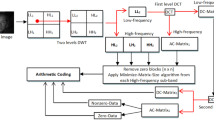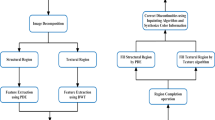Abstract
Differing from common 2D images, a texture map, since it is used to project onto a 3D model in 3D space, not only contains 2D texture information, but also implicitly associates certain 3D geometric information. Related to this, an effective 3D geometry-dependent texture map compression method with hybrid region of interest (ROI) coding is proposed in this paper. We regard the visually important area of the texture map as the ROI. To acquire the visually important areas of the texture map, we take into account information from both the 3D geometry and 2D texture maps, depicting the saliency of the textured model, distortion of the texture mapping, and boundary of the texture atlas. These visually important areas are expressed as a visual importance map. According to the particularity of the texture map, a hybrid ROI coding method that utilizes Max-Shift and an improved post compression rate distortion (PCRD) technique is presented, guided by this visual importance map. To find the exact wavelet coefficients pertaining to these ROIs before carrying out the hybrid ROI coding, this paper proposes a stochastic coefficient priority mask map computational method. Experimental results show that the visually important areas of the texture image have a better visual effect and that a good rendering result can be obtained from the texture mapping.
Similar content being viewed by others
References
Kaluanpur A, Neklesa V P, Taylor C R, et al. Evaluation of JPEG and wavelet compression of body CT images for direct digital teleradiologic transmission. Radiology, 2000, 217: 772–779
Said A, Pearlman W A. A new fast and efficient image codec based on set partitioning in hierarchical trees. IEEE Trans Circ Syst Video Technol, 1996, 6: 243–250
Taubman D S, Marcellin MW. JPEG2000 Image Compression Fundamentals, Standards and Practice. Boston: Kluwer Academic Press, 2001
Itti L. Automatic foveation for video compression using a neurobiological model of visual attention. IEEE Trans Image Process, 2004, 13: 1304–1318
Aziz M Z, Mertsching B. Fast and robust generation of feature maps for region-based visual attention. IEEE Trans Image Process, 2008, 17: 633–644
Paul L R. A simple method for detecting salient regions. Patt Recog, 2009, 45: 2363–2371
Guo C L, Zhang L M. A novel multiresolution spatiotemporal saliency detection model and its applications in image and video compression. IEEE Trans Image Process, 2010, 19: 185–198
Taubman D, Marcellin M W, Rabbani M. JPEG2000: image compression fundamentals, standards and practice. J Electron Imaging, 2002, 11: 286–290
Iourcha K, Nayak K, Zhou H. System and method for fixed-rate block-based image compression with inferred pixel values. United States Patent 5956431
Ström J, Akenine-Möller T. High-quality, low-complexity texture compression for mobile phones. In: Proceedings of the ACM SIGGRAPH/Eurographics Conference on Graphics Hardware, Los Angeles, 2005. 63–70
Fenny S. Texture compression using low-frequency signal modulation. In: Proceedings of the ACM SIGGRAPH/Eurographics Conference on Graphics Hardware, Los Angeles, 2003. 84–91
Ström J, Pettersson M. ETC2: texture compression using invalid combinations. In: Proceedings of the 22nd ACM SIGGRAPH/Eurographics Symposium on Graphics Hardware, Aire-la-Ville, 2007. 49–54
Itti L, Koch C, Niebur E. A model of saliency-based visual attention for rapid scene analysis. IEEE Trans Patt Anal Mach Intell, 1998, 20: 254–1259
Lin Y W, Fang B, Tang Y Y. A computational model for saliency maps by using local entropy. In: AAAI Conference on Artificial Intelligence, Chongqing, 2010. 967–973
Borji A, Itti L. State-of-the-art in visual attention modeling. IEEE Trans Patt Anal Mach Intell, 2013, 35: 185–207
Hou X, Zhang L. Saliency detection: a spectral residual approach. In: Proceedings of the IEEE Conference on Computer Vision and Pattern Recognition, Minneapolis, 2007. 1–8
Achanta R, Hemami S S, Estrada F J, et al. Frequency-tuned salient region detection. In: Proceedings of the IEEE Conference on Computer Vision and Pattern Recognition, Miami, 2009. 1597–1604
Bian P, Zhang L. Biological plausibility of spectral domain approach for spatiotemporal visual saliency. In: ICONIP 2008, Auckland, 2008. 251–258
Pablo G T, Ramon V J, Maria J L, et al. Image compression: Max-Shift ROI encoding options in JPEG2000. Comput Vis Image Underst, 2008, 109: 139–145
Joan B R, Joan S S, Francesc A L. JPEG2000 ROI coding with fine-grain accuracy through rate-distortion optimization techniques. IEEE Signal Process Lett, 2009, 16: 45–48
Joel A, Mathias L C, Charilaos C. Region of interest coding in JPEG 2000. Signal Process Image Commun, 2002, 17: 105–111
Joan B R, Joan S S, Francesc A L. JPEG2000 ROI coding through component priority for digital mammography. Comput Vis Image Underst, 2011, 115: 59–68
Sander P V, Snyder J, Gortler S J. Texture mapping progressive meshes. In: Proceedings of ACM SIGGRAPH, Los Angeles, 2001. 409–416
Wang N, Simoncelli E, Bovik A. Multiscale structural similarity for image quality assessment. In: Proceedings of the 37th IEEE Asilomar Conference on Signals, Systems and Computers, Pacific Grove, 2003. 1398–1402
Lindstrom P. Model simplification using image and geometry-based metrics. Dissertation for the Doctoral Degree. Georgia: Georgia Institute of Technology, 2000
Author information
Authors and Affiliations
Corresponding author
Rights and permissions
About this article
Cite this article
Yang, B., Jing, J., Wang, X. et al. 3D geometry-dependent texture map compression with a hybrid ROI coding. Sci. China Inf. Sci. 57, 1–15 (2014). https://doi.org/10.1007/s11432-013-4897-3
Received:
Accepted:
Published:
Issue Date:
DOI: https://doi.org/10.1007/s11432-013-4897-3




